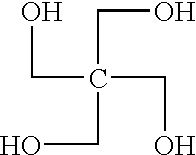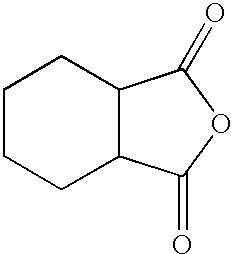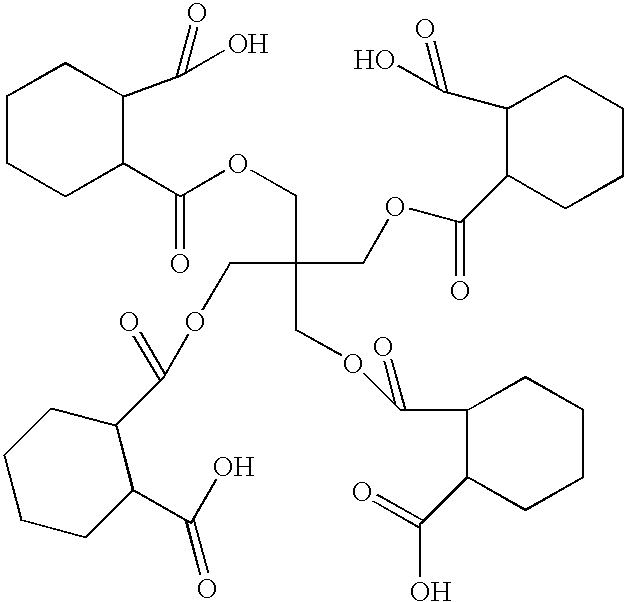Polymeric pigment dispersant utilized as a grind resin for pigments and method of preparing the same
a polymer pigment and dispersant technology, applied in the field of pigment dispersant, can solve the problems of ineffective inadequate grind resins of prior art including polyacrylate-based emulsions, and achieve low molecular weight, low viscosity, and sufficient time
- Summary
- Abstract
- Description
- Claims
- Application Information
AI Technical Summary
Benefits of technology
Problems solved by technology
Method used
Image
Examples
example 1
The polyester carboxylate polymeric pigment dispersant was prepared by adding and reacting the following parts, by weight, unless otherwise indicated.
TABLE 1 Amount Amount Reactant (moles) (grams) Other Pentaerythritol 0.5 68.0 -- [PE] Hexahydrophthalic 2.0 308.0 -- anhydride [HHPA] Glycidylneodecanoate 0.5 119.6 -- [CARDURA E 10S] Dimethylethanolamine 1.5 267.0 267.0 grams of a 50% soln. [DMEA] of DMEA 133.5 grams of DMEA and 133.5 grams of H.sub.2 O
Per the above table, Table 1, 308.0 grams of HHPA were added in a reaction flask to 65.0 grams of PE. The reaction flask, including the PE and HHPA, was heated via a conventional heat supply to a temperature of 120.degree. C. to 125.degree. C., when an exotherm was observed, peaking at approximately 150.degree. to 160.degree. C. After this exotherm, the batch was allowed to cool and was maintained at 130.degree. C. for approximately two hours. Standard titration for acid number revealed that the reaction to form the intermediate compoun...
example 2
The completed polyester carboxylate polymeric pigment dispersant was then incorporated into a modified pigment dispersion according to the following table, Table 2.
TABLE 2 Pigment Dispersion Component Amount (modified) (grams) Other POLYESTER CARBOXYLATE 3.72 -- POLYMERIC PIGMENT DISPERSANT water 11.40 -- [de-ionized water] co-solvent 0.72 -- [propyl propasol] pigment 41.40 Added pigment gradually over [titanium dioxide, TiO.sub.2 ] time and under stirring Appearance Evaluation N / A Glossy appearance of modified pigment dispersion on a 2 mil thickness drawdown Stability Type - shelf Acceptable RT (room temp.) .times. 3 months Stability Type - heat Acceptable 140.degree. F. .times. 2 weeks
Per the above table, Table 2, 3.72 grams of the polyester carboxylate polymeric pigment dispersant and 11.40 grams of de-ionized water and 0.72 grams of propyl propasol were added together to prepare a modified pigment dispersion for an aqueous coating composition. Next, 41.40 grams of TiO.sub.2 pigm...
example 3
The completed polyester carboxylate polymeric pigment dispersant was also incorporated into a `scaled-up` pigment dispersion according to the following table, Table 3.
TABLE 3 Pigment Dispersion Component Amount (scale-up) (grams) Other POLYESTER CARBOXYLATE 186.0 -- POLYMERIC PIGMENT DISPERSANT Water 708.0 -- [de-ionized water] (570.0 + 138.0) co-solvent 36.0 -- [propyl propasol] pigment 2070.0 Added pigment gradually over [titanium dioxide, TiO.sub.2 ] time and under stirring Appearance Evaluation N / A Glossy appearance of scaled-up pigment dispersion on a 2 mil thickness drawdown Particle Size Evaluation N / A No pigment particles were observed utilizing standard grind gauge method (thus indicating a pigment particle size of less than 6 microns) Stability Type - shelf Acceptable RT (room temp.) .times. 3 months Stability Type - heat Acceptable 140.degree. F. .times. 2 weeks
Per the above table, Table 3, 186.0 grams of the polyester carboxylate polymeric pigment dispersant and 570.0 gr...
PUM
| Property | Measurement | Unit |
|---|---|---|
| temperature | aaaaa | aaaaa |
| temperature | aaaaa | aaaaa |
| temperatures | aaaaa | aaaaa |
Abstract
Description
Claims
Application Information
 Login to View More
Login to View More - R&D
- Intellectual Property
- Life Sciences
- Materials
- Tech Scout
- Unparalleled Data Quality
- Higher Quality Content
- 60% Fewer Hallucinations
Browse by: Latest US Patents, China's latest patents, Technical Efficacy Thesaurus, Application Domain, Technology Topic, Popular Technical Reports.
© 2025 PatSnap. All rights reserved.Legal|Privacy policy|Modern Slavery Act Transparency Statement|Sitemap|About US| Contact US: help@patsnap.com



